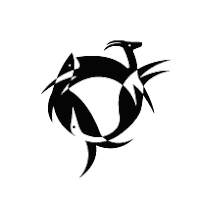So the semester just finished and that means our independent study is through, too. While it certainly was a crazy semester, we accomplished all that we set out to do, including all of the projects we lined up for ourselves. Not only did we learn about the business of being in the design business, we also found out what it was like to work together closely to meet our goal. We've both worked together on class projects before, but this was a different experience because we both had equal control over every project. It became important to compromise, a big part of which was just learning how to compromise. Some things you learn to let go and others you keep, but everything is for the sake of the project.
Doing this independent study also opened up the opportunity to learn about owning a design firm. Through research we discovered what's important in starting and maintaining a business. Designing with the real world in mind also kept things in perspective. As a new or even established firm, budget is everything. When designing our stationary, we took into consideration paper and printing costs, going for the least expensive materials that still looked good and enhanced our identity system. Besides budgetary issues, we also had to consider mailing standards. Many of our other school projects don't consider real world issues as much, so this was a good experience.
Starting this blog was also a great way to connect with the design community and to keep track of all of our progress.
Thursday, December 18, 2008
Tuesday, December 16, 2008
What's up, Unit? Part Deux
Here's another update of the progress we've made so far:
—Letterhead, envelope, business card, and sticker components produced and comped.
—Branding book produced and comped.
—Promotional mailer completed; awaiting production.
—Paste It Forward project in process; to be completed shortly.
—Letterhead, envelope, business card, and sticker components produced and comped.
—Branding book produced and comped.
—Promotional mailer completed; awaiting production.
—Paste It Forward project in process; to be completed shortly.
Saturday, December 6, 2008
What's up, Unit?
Whew. This semester has been insane, but we're still alive and kicking. Here's an update of the progress we've made so far:
—Letterhead, envelope, business card, and sticker components designed and completed;
awaiting production.
—Branding book in process; to be completed shortly.
—Promotional mailer in process; to be completed shortly.
—Paste It Forward project in process; to be completed shortly.
For those not in the know, Paste It Forward is a Internet-based project Jess started two years ago to gather and display advice and adages from the world over. Since then, she's gotten all kinds of responses from several different countries, even a picture or two. The goal is to collect and display the responses so they can passed—or "pasted"—on to someone else. Unit's goal is to take this project out of the digital realm and into the world of print.
The Paste It Forward website can be accessed here.
—Letterhead, envelope, business card, and sticker components designed and completed;
awaiting production.
—Branding book in process; to be completed shortly.
—Promotional mailer in process; to be completed shortly.
—Paste It Forward project in process; to be completed shortly.
For those not in the know, Paste It Forward is a Internet-based project Jess started two years ago to gather and display advice and adages from the world over. Since then, she's gotten all kinds of responses from several different countries, even a picture or two. The goal is to collect and display the responses so they can passed—or "pasted"—on to someone else. Unit's goal is to take this project out of the digital realm and into the world of print.
The Paste It Forward website can be accessed here.
Interview: Emily Goldstein of M Design
Giulia here. A while back, I was lucky enough to chat with Emily Goldstein of M Design here in Baltimore and ask her a couple questions about being a designer and owning her own business. Emily and I worked together for one of my Flex projects last year, so connections really can help you out!
Did you enter the field right after college or did you wait? If you went straight to work, what was your first job like?
I didn't know that I was good at this stuff after college, so I worked in non-profit, organizing events, and it later became clear that I might be good at graphic design, so I went back to grad school at age 31.
Do you feel graduate school is a necessary step in a designer's education? If so, do you recommend any schools?
It depends. Formal training is necessary— but there are good undergrad programs for that... Carnegie Melon is one example. Grad school is always a plus - but I don't believe anyone can be a designer without knowledge of the history of design, formal training in the principles and strategies of space and layout, and advanced training in typography.
Were you ever unsure about your future in design? If you were, what did you do to stay on track and keep going?
Not unsure—maybe un-confident! Just stayed around the right people—professors and colleagues—to get their advice.
Why and how did you decide to start your own firm?
Got sick of working for other people!
What has been the biggest challenge being your own boss?
Sales and marketing.
Design is always changing, so what do you do to stay current and fresh?
Magazines, books, AIGA events, chatting with other designers.
How important are trends in design? Do you think it's more important to be trendy or to stay classic?
Clean, clear, concise design never goes out of style.
Do you have a style or certain way you design? Do you think it's important to have a trademark design style or should designers execute design that always looks different?
Designers should do what is appropriate for the CLIENT. If the piece does not in some way enhance the client's business (bring in more members, more sales, etc...) then the designer did not do her job!
What's something you know now that you wish you knew when you first became a designer?
The client wants to hear about how you are going to help them increase their bottom line, NOT about fonts and colors!
Recently, and on a related note, I've started to wonder—and even worry— what it means to be a female designer in a seemingly male-dominated industry. It's certainly not a matter of work quality, that's for sure. And it's not that women aren't making names for themselves in design, either. It's more like their efforts go unrecognized. Every time I make my rounds on the design blog circuit or flip through an annual or collective in the library, it seems like far more men are featured. Why? Are women as a whole just less attracted to design? Or are men just more aggressive when it comes to self-promotion and marketing? I'm not sure. I don't think it's something I'll really know the answer to until I've left the comfortable cocoon of MICA and fully immersed myself in the field. Either way, I was happy to stumble across this book recently, titled Women of Design. The book is authored by Armin Vit and Bryony Gomez-Palacio, the husband and wife team who run Under Consideration, and mentions our very own Ellen Lupton.
Edit: Bryony was kind enough to point out my mistake about the authors of Women of Design. Apologies, and both Jess and I look forward to reading the book!
Did you enter the field right after college or did you wait? If you went straight to work, what was your first job like?
I didn't know that I was good at this stuff after college, so I worked in non-profit, organizing events, and it later became clear that I might be good at graphic design, so I went back to grad school at age 31.
Do you feel graduate school is a necessary step in a designer's education? If so, do you recommend any schools?
It depends. Formal training is necessary— but there are good undergrad programs for that... Carnegie Melon is one example. Grad school is always a plus - but I don't believe anyone can be a designer without knowledge of the history of design, formal training in the principles and strategies of space and layout, and advanced training in typography.
Were you ever unsure about your future in design? If you were, what did you do to stay on track and keep going?
Not unsure—maybe un-confident! Just stayed around the right people—professors and colleagues—to get their advice.
Why and how did you decide to start your own firm?
Got sick of working for other people!
What has been the biggest challenge being your own boss?
Sales and marketing.
Design is always changing, so what do you do to stay current and fresh?
Magazines, books, AIGA events, chatting with other designers.
How important are trends in design? Do you think it's more important to be trendy or to stay classic?
Clean, clear, concise design never goes out of style.
Do you have a style or certain way you design? Do you think it's important to have a trademark design style or should designers execute design that always looks different?
Designers should do what is appropriate for the CLIENT. If the piece does not in some way enhance the client's business (bring in more members, more sales, etc...) then the designer did not do her job!
What's something you know now that you wish you knew when you first became a designer?
The client wants to hear about how you are going to help them increase their bottom line, NOT about fonts and colors!
Recently, and on a related note, I've started to wonder—and even worry— what it means to be a female designer in a seemingly male-dominated industry. It's certainly not a matter of work quality, that's for sure. And it's not that women aren't making names for themselves in design, either. It's more like their efforts go unrecognized. Every time I make my rounds on the design blog circuit or flip through an annual or collective in the library, it seems like far more men are featured. Why? Are women as a whole just less attracted to design? Or are men just more aggressive when it comes to self-promotion and marketing? I'm not sure. I don't think it's something I'll really know the answer to until I've left the comfortable cocoon of MICA and fully immersed myself in the field. Either way, I was happy to stumble across this book recently, titled Women of Design. The book is authored by Armin Vit and Bryony Gomez-Palacio, the husband and wife team who run Under Consideration, and mentions our very own Ellen Lupton.
Edit: Bryony was kind enough to point out my mistake about the authors of Women of Design. Apologies, and both Jess and I look forward to reading the book!
Wednesday, November 12, 2008
Design we love
It's time for some gratuitous eye candy here at Unit. Without further ado, stuff we adore by talented people.
Graphics & Illustration
















Branding & Logos









Typography











Photography


All work copyright its respective designer(s)/artist(s). No copyright infringement intended. Unit does not own nor produced any of the work shown here in this post.
Graphics & Illustration
















Branding & Logos









Typography










Photography


All work copyright its respective designer(s)/artist(s). No copyright infringement intended. Unit does not own nor produced any of the work shown here in this post.
Sunday, November 9, 2008
Research: Why is branding necessary?
Jess here. As it turns out, branding originally meant burning: [in verb sense] To mark permanently with a hot iron; [in noun sense] To mark of ownership made by marking.
Today branding is the apple that didn't fall far from the tree. Today the dictionary lists branding as the promotion of a particular product or company by means of advertising and distinctive design. What it doesn't mention, is branding is the basis of a identity and recognition of not just a product, company, or business, but of an idea, promise, entity persona, or image. This additional part gives what is being promoted (sell-ability) within a competitive market in which consumers have a choice amongst various products or service providers that fill the same need. Your product or service's sell-ability is vital to survive when what you offer is supplied by various sources (competitors).
In this way branding can lead to a well known brand presence, the successful growth of a company and give it a sustainable relevance in a fast-moving marketplace.
Let's look at the company Coca-Cola:

Coca-Cola (Coke) has been around several decades and that is putting it lightly.
They began with a strong mark and kept with the same message in all their advertising.

Coke = happy


While quality of product serves a part in the consumers response to advertising, the brand itself became a unique mark and identifier.
Coke has kept the overall look and message the same, even with various slogans and statements like"always Coca-Cola" or "have a Coke."

The branding of this product is one that carries the idea of consumer happiness and enjoyment in every advertisement slogan and jingle. This 360 degree branding marvel, still stands as strong as ever and is a shining example of what good branding can do for not only one product but the company itself.

One last example of Coke's presence today. It is not just a product or one drink, it is everywhere. For those of you familiar with Charles and Ray Eames, Vitra was the company that had rights to replicate and distribute their furniture designs. Coca Cola Has its own line of furniture from their themed selection which was available through Vitra. These pieces have been featured over the decades in Coke's ads and the buildings of various retailers, restaurants and distributors now sold directly for the consumer or Coke enthusiast.
Sunday, November 2, 2008
Research: What goes into a branding book? Part II
Jess here again. Another important thing to include is the typeface and its variations so there is consistency within all additional text on any branded materials. Products such as business cards letterheads and envelopes should have guidelines as well. (See some good examples below.)












Subscribe to:
Posts (Atom)




